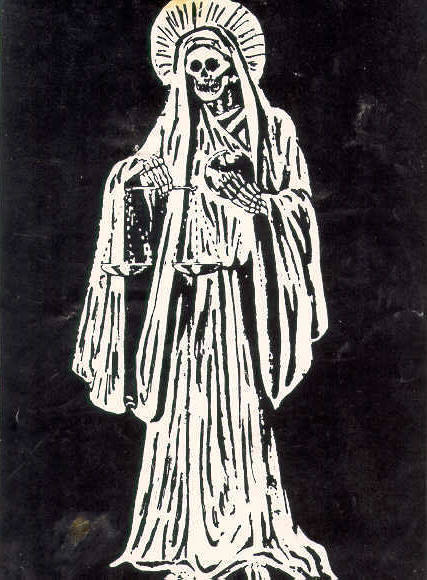Difference between revisions of "Template:POTD protected"
Occultwiki (talk | contribs) |
Occultwiki (talk | contribs) |
||
| (32 intermediate revisions by the same user not shown) | |||
| Line 1: | Line 1: | ||
{| role="presentation" style="margin:0 3px 3px; width:100%; text-align:left; background-color:transparent; border-collapse: collapse; " | {| role="presentation" style="margin:0 3px 3px; width:100%; text-align:left; background-color:transparent; border-collapse: collapse; " | ||
|style="padding:0 0.9em 0 0;" | [[File: | |style="padding:0 0.9em 0 0;" | [[File:Muerte-Blanca 6.jpg|300px|thumb|]] | ||
|style="padding:0 6px 0 0"| | |style="padding:0 6px 0 0"| | ||
'''[[ | '''[[Santa Muerte]]''' is a female deity and folk [[saint]] in Mexican folk [[Christianity|Catholicism]] and [[Paganism|Neopaganism]]. A personification of death, she is associated with healing, protection, and safe delivery to the afterlife by her devotees. Despite condemnation by the Catholic Church, and more recently Evangelical pastors, her cult has become increasingly prominent since the turn of the 21st century. | ||
Iconographically, Santa Muerte is a skeleton dressed in female clothes or a shroud, and carrying both a scythe and a globe. Santa Muerte is distinguished as female not by her skeletal form but rather by her attire and hair. The latter was introduced by a believer named Enriqueta Romero. | |||
<p><small>Photo Credit: Wikimedia Commons</small></p> | |||
<p><small> | |||
[[:Category:Images|'''(More Images)''']] | [[:Category:Images|'''(More Images)''']] | ||
<div class="potd-recent" style="text-align:right;"> | <div class="potd-recent" style="text-align:right;"> | ||
Latest revision as of 21:39, 13 May 2024
|
Santa Muerte is a female deity and folk saint in Mexican folk Catholicism and Neopaganism. A personification of death, she is associated with healing, protection, and safe delivery to the afterlife by her devotees. Despite condemnation by the Catholic Church, and more recently Evangelical pastors, her cult has become increasingly prominent since the turn of the 21st century. Iconographically, Santa Muerte is a skeleton dressed in female clothes or a shroud, and carrying both a scythe and a globe. Santa Muerte is distinguished as female not by her skeletal form but rather by her attire and hair. The latter was introduced by a believer named Enriqueta Romero. Photo Credit: Wikimedia Commons |
